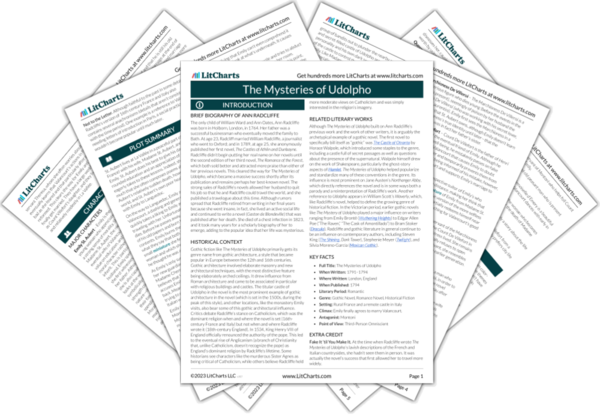The black veil, which resembles a mourning garment and hangs over a mysterious object in the castle at Udolpho, symbolizes mortality and specifically how some people try to forget their own mortality by putting a metaphorical veil over it. Emily initially thinks that the black veil hangs over a painting. She eventually works up the courage to look under the veil, and she sees something so horrifying that the narration of the novel does not initially reveal what she sees. It only comes out near the end of the novel that what Emily saw was a wax figure of a decaying corpse, with flies coming out of it. The wax figure belonged to an original member of the Udolpho family, who kept it as a reminder of his own mortality. But future generations found the sculpture too disturbing, so they covered it with a black veil.
Montoni, the current owner of Udolpho, keeps the black veil over the wax figure, showing how he refuses to reckon with his own mortality. Rejecting the Christian morality that Emily embodies, with its focus on eternity, Montoni acts in materialistic ways, putting worldly matters first. In this way, he refuses to see how he is himself mortal, a trait he shares with several other characters in the novel including Madame Montoni, Orsino, and Count Morano. In contrast, although Emily’s own encounter with the black veil frightens her and even causes her to faint, she ultimately becomes stronger by confronting her mortality. Indeed, her experience helps her to reaffirm her desire to please God with acts of selflessness. And so, various characters’ relationships to the black veil represent the futility of trying to ignore their mortality. I also highlights the benefits of facing mortality directly, which can include increased faith and selflessness.
Black Veil Quotes in The Mysteries of Udolpho
Passing the light hastily over several other pictures, she came to one concealed by a veil of black silk. The singularity of the circumstance struck her, and she stopped before it, wishing to remove the veil, and examine what could thus carefully be concealed, but somewhat wanting courage.
Emily passed on with faltering steps, and having paused a moment at the door, before she attempted to open it, she then hastily entered the chamber, and went towards the picture, which appeared to be enclosed in a frame of uncommon size, that hung in a dark part of the room. She paused again, and then, with a timid hand, lifted the veil; but instantly let it fall—perceiving that what it had concealed was no picture, and, before she could leave the chamber, she dropped senseless on the floor.
When she recovered her recollection, the remembrance of what she had seen had nearly deprived her of it a second time. She had scarcely strength to remove from the room, and regain her own; and, when arrived there, wanted courage to remain alone.
It seemed to conceal a recess of the chamber; she wished, yet dreaded, to lift it, and to discover what it veiled: twice she was withheld by a recollection of the terrible spectacle her daring hand had formerly unveiled in an apartment of the castle, till, suddenly conjecturing, that it concealed the body of her murdered aunt, she seized it, in a fit of desperation, and drew it aside. Beyond, appeared a corpse, stretched on a kind of low couch, which was crimsoned with human blood, as was the floor beneath. The features, deformed by death, were ghastly and horrible, and more than one livid wound appeared in the face. Emily, bending over the body, gazed, for a moment, with an eager, frenzied eye; but, in the next, the lamp dropped from her hand, and she fell senseless at the foot of the couch.
“Do you indeed live,” said Emily, at length, “or is this but a terrible apparition?” She received no answer, and again she snatched up the hand. “This is substance,” she exclaimed, “but it is cold—cold as marble!” She let it fall. “O, if you really live, speak!” said Emily, in a voice of desperation, “that I may not lose my senses—say you know me!”
“I do live,” replied Madame Montoni, “but—I feel that I am about to die.”
It may be remembered, that, in a chamber of Udolpho, hung a black veil, whose singular situation had excited Emily’s curiosity, [...] on lifting it, there appeared, [...] a human figure of ghastly paleness[...]. What added to the horror of the spectacle, was, that the face appeared partly decayed and disfigured by worms, which were visible on the features and hands. On such an object, it will be readily believed, that no person could endure to look twice. Emily, it may be recollected, had, after the first glance, let the veil drop, and her terror had prevented her from ever after provoking a renewal of such suffering, as she had then experienced. Had she dared to look again, her delusion and her fears would have vanished together, and she would have perceived, that the figure before her was not human, but formed of wax.












